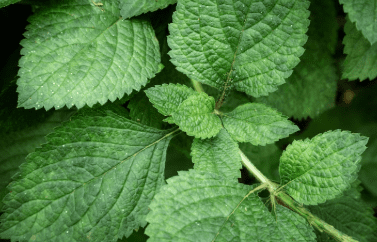
Urtica urens
Latin name: Urtica urens
Short name: Urt-u
Common name: Dwarf Nettle | Small Nettle | Annual Nettle | Stinging Nettle
Primary miasm: Psoric Secondary miasm(s): Sycotic
Kingdom: Plants
Family: Urticaceae
- Symptomatology
- Remedy Information
- Differentiation & Application
Prepared from the fresh flowering plant Urtica urens, part of the Urticaceae family. The plant is rich in histamine, formic acid, acetylcholine, serotonin, and other irritants responsible for its intense stinging and inflammatory action. It grows wild across Europe and North America and is distinguished from Urtica dioica (common nettle) by its smaller leaves and more intense sting.
Used in herbalism for rheumatism, diuresis, scurvy, anaemia, gout, and as a galactagogue. Also applied externally in burns and minor wounds. In traditional systems, Urtica urens has been used as a spring tonic and for promoting blood purification.
Although not classically proved in the Hahnemannian tradition, its toxicological and clinical symptoms were gathered through extensive clinical use and confirmed by Clarke, Hering, Boericke, and others. It has developed a strong clinical profile through its affinity for skin, glands, and uric acid diathesis.
- Skin – hives, eruptions, itching, urticaria, burns, eczema, insect stings
- Mammary glands – suppressed lactation, agalactia, mastitis, swelling, induration
- Urinary tract – uric acid diathesis, burning urination, renal irritation
- Joints – uric acid rheumatism, gout
- Glands – lymphatic activity, especially when suppressed or obstructed
- Nervous system – hypersensitivity, neuralgia following suppression
- Blood – increased uric acid, uræmic irritation
- Left side – especially left breast and left limbs
- Circulation – reactions of the blood and vascular tissues to allergens or injury
- Digestive tract – after allergic food reactions or exposure to shellfish
- Cold applications, especially to skin and breasts
- Rubbing or scratching (initially relieves itching before aggravating)
- Letting out eruptions; suppressed discharges worsen the state
- Rest; remaining still relieves skin and joint complaints
- Sweating freely or resuming menstruation/lactation
- Regular movement for rheumatic complaints
- Outdoors; cool, dry air improves general condition
- Heat and warmth, especially warmth of bed or heated rooms
- Touch; skin becomes hyperirritable and tender
- Suppression of discharges—milk, menses, perspiration, eruptions
- Overexertion, particularly in sensitive individuals
- Exposure to shellfish, dairy, or rich, fatty foods
- Sudden cooling, especially after overheating
- Weaning, lactation failure, or after childbirth
- Damp and foggy weather
- Seasonal changes, especially spring and early summer
- Apis mellifica – Similar burning and oedema, but Apis is chilly and thirstless
- Rhus toxicodendron – More restlessness, vesicular eruptions, < wet weather
- Sulphur – More systemic and deeper acting; generalised burning and aggravation from heat
- Histaminum – Acute allergic states without characteristic modalities
- Lachesis – Left-sided, glandular, but more congestive and intense mental symptoms
- Complementary: Apis, Rhus tox., Belladonna
- Antidotes: Apis, Camphora
- Follows well: Sulphur, Pulsatilla
- Precedes well: Calc. carb., Lycopodium
- Inimical: Phosphorus (occasionally)
Urtica urens represents the eruptive, inflammatory force of nature—a reaction of the body trying to eliminate internal disturbance through the skin and glands. Its essence lies in hypersensitivity, blockage of natural outlets, and overreaction to stimuli, particularly food and heat. Whether it is milk that won’t come, sweat that won’t break, or rashes that won’t fully express, Urtica urens acts to liberate and restore. It’s a vital remedy for modern allergenic syndromes, breastfeeding crises, gout, and superficial burns—bridging the gap between acute irritative states and chronic retention patterns.
- Use in urticaria, eczema, or burns, esp. if < heat, > cold
- Excellent for agalactia, especially with breast swelling
- Works well in infants with allergic rashes and green stools
- Consider for chronic gouty pain, esp. if skin symptoms alternate
- External use of tincture (1x diluted) complements internal treatment
- Low potencies (3X–6X) best for organ support; 30C and up for systemic reaction
Skin
- Urticaria, < shellfish
- Burns, first degree
- Eczema with burning
- Eruptions alternating with asthma
Female
- Agalactia
- Mastitis, left side
- Pain in nipples during nursing
Generalities
- < Warmth, > cold applications
- Uric acid diathesis
- < Suppressed eruptions
Extremities
- Gouty pain
- Urticaria of limbs
- Burning in joints
- John Henry Clarke – Dictionary of Practical Materia Medica: Principal source of clinical indications and therapeutic affinities
- William Boericke – Pocket Manual of Materia Medica: Provided acute modalities, skin and gland symptoms
- C. Hering – Guiding Symptoms: Supported skin, urinary, and allergic characteristics
- James Kent – Lectures on Materia Medica: Confirmed modalities and lactation-related indications
- Robin Murphy – Lotus Materia Medica: Expanded repertory and modern applications in allergy and uric acid diathesis
